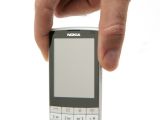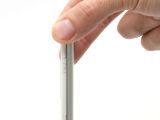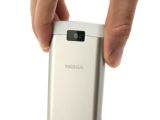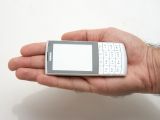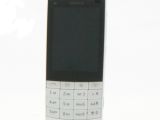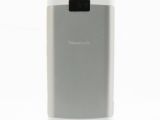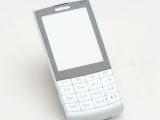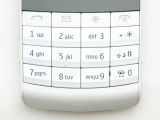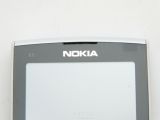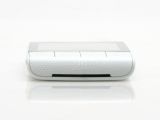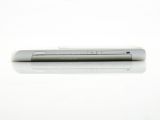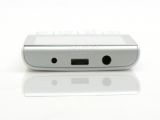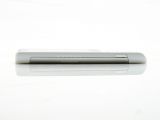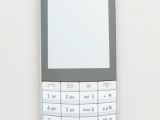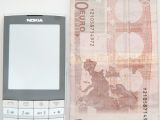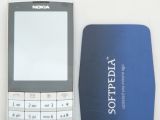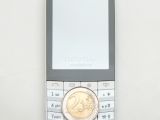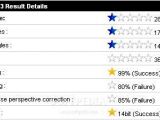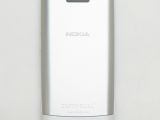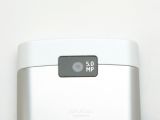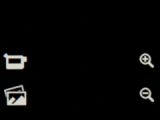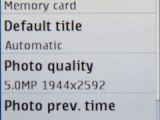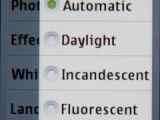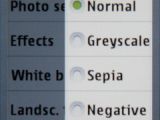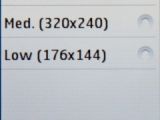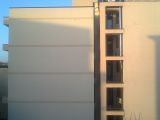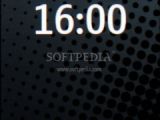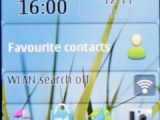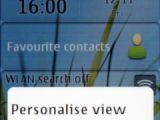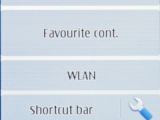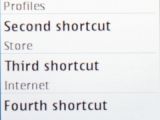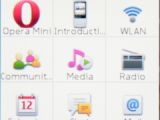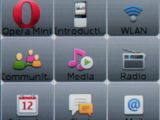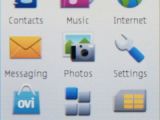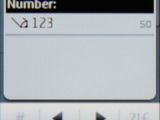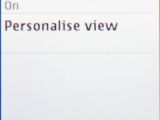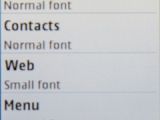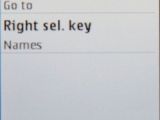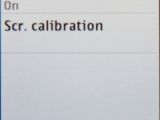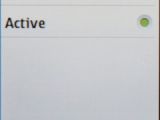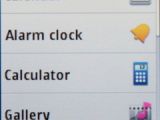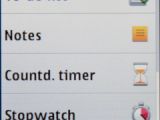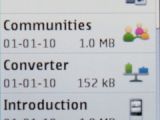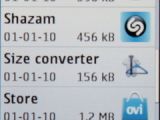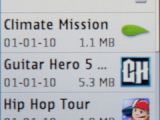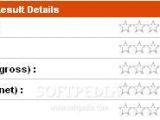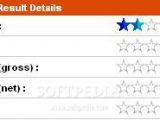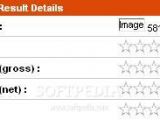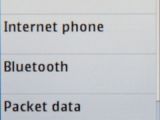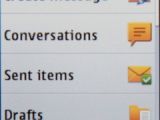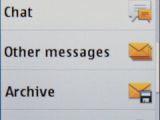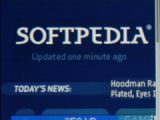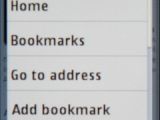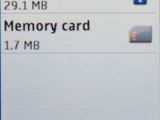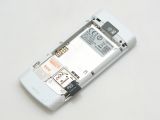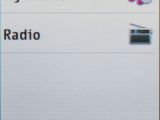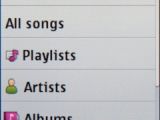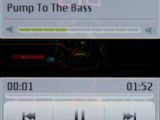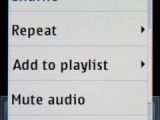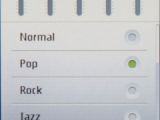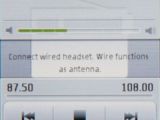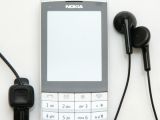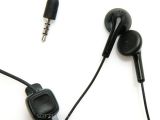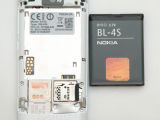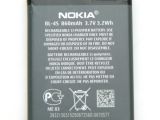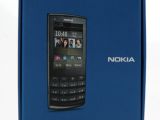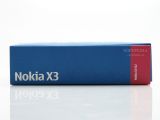As the name suggests, Nokia X3-02 is a touchscreen handset, but what's really interesting is the fact that it does not come with Symbian OS, but with the S40 UI. In fact, this is the first Nokia touchscreen mobile phone to use the S40 UI platform.
Nokia's experiment was successful, as the porting of the S40 UI on a touchscreen device is superior to that of the Symbian OS.
Things are more intuitive and easier to reach, as you won't need to click three or four times to access the features you need the most. Furthermore, the feature-phone comes with one of the best resistive touchscreens ever used by Nokia in its handsets.
Announced in August 2010, Nokia X3-02 Touch and Type was launched on the market in September 2010. Currently the handset can be purchased for about 250 US dollars without a subscription.
Potential customers can choose from five available color schemes: White Silver, Dark Metal, Petrol Blue, Pink and Lilac.
DesignThere's no doubt about it, Nokia X3-02 Touch and Type is quite a looker with its super sleek form factor and stylish design. I've got the chance to test the white version of the handset, which is simply adorable. It can fit into any pocket and is feather-like when it comes to weight, as you won't even feel it.
It's true the handset features a rather small 2.2-inch touch display, but makes it up for it with its responsiveness. The X3-02 measures 106.2 x 48.4 x 9.6 mm and weighs only 78g (battery included). This is one of the few Nokia phones that drop below the 10mm thickness barrier.
Another innovation implemented by Nokia is the 3-row phone keypad, instead of the standard one with four rows. The three keys at the bottom (*, # and 0) have been moved to the right now, one on each row. It will take a while to get used to it, but it helped Nokia keep the phone's size smaller.Above the 3-row phone keypad there's one more string of four keys that replaces the contextual keys that were usually placed below every Nokia's handset display. From left to right, these are the Accept calls key, Messaging, Music player and Reject calls key, which is also used to power on/off the handset. These four keys have been covered by an extra layer of translucent plastic to make them stand out from the phone's keypad.
Overall the keys are large enough and responsive, so typing fast won't be a problem. Misspelling might be a problem at first until one gets used with the new layout.
The right side of the phone features a very small lanyard eyelet, a volume key and a lock/unlock button. On top of the phone there's a 3.5mm audio jack, a microUSB port, as well as the charger plug. The bottom of the phone features a dot-like pattern and the loudspeaker.The mouthpiece has been embedded directly into the keypad, between the 9 and 0 keys. The only things worth mentioning above the display are the earpiece and the ambient light sensor. On both sides of the phone there are two latches which open the battery cover when they're pressed at the same time.
The 5-megapixel camera on the back lacks a flash and it is covered by a thin plastic layer that is supposed to protect the lens against scratches.
The microSD card slot has been placed under the metallic back cover, next to the SIM slot and does not require users to remove the battery. The plastic used for manufacture gives the phone almost a luxurious touch, while the metallic back cover ensures that the phone has a solid build. Overall, Nokia X3-02 is a 10 out of 10 phone, when it comes to design and ergonomics.Display and Camera
Nokia X3-02 Touch and Type comes with a 2.4-inch TFT resistive touchscreen with up to 262K colors and 240 x 320 pixel resolution.
This is the first Nokia S40 UI feature-phone to get a touchscreen. Even though the phone does not have an on-screen input method, using the touchscreen to navigate the menus is a real pleasure. This is by far the best resistive touchscreen used by Nokia in one of its phones.
The quality of the image is exceptional and that includes brightness and contrast. When exposed to strong sunlight users won't have troubles reading what's on the screen. The only downside is the lack of a built-in accelerometer for display auto-rotation and proximity sensor. The latter really hurts during calls, as the touchscreen is not locked and touching it with your ear may result in opening apps accidentally or call interruptions. While the number may seem impressive, the 5-megapixel camera fails to impress when it comes to picture quality. There are no advanced functions such as smile detection, face recognition or blink prevention. The camera even lacks some of the more basic features such as LED flash or autofocus, (which was replaced with fixed focus). The interface of the camera is pretty standard and intuitive with settings such as White Balance and Effects. The camera captures pictures with a maximum resolution of 2592x1944 pixels, while video clips can be recorded in QVGA at up to 30 fps and VGA at up to 15 fps.For those that use the phone's camera pretty often, the lack of a dedicated camera button might be a downside. Further, the phone even lacks the usual D-pad button, so users will have to rely on the “touch-n-shoot” button that appears on the screen.
The quality of the pictures is not that good, as they look too noisy and the contrast is pretty low. Check out the samples below for a more accurate opinion about the quality of the photo snapper.
Menu and SoftwareNokia X3-02 runs on an S40 6th Edition interface, which is the latest user interface coming from Nokia. The interface has been ported to fit the touchscreen and with the removal of the D-pad users will have to either use the display to navigate through the menus or the phone's keypad for the corresponding menu.
While the environment remained the same, the interface was touch-optimized. The Active standby can be customized by touching and pressing on one of the four bars displaying on the homescreen and choosing Personalize view.
The last bar on the screen is called the Shortcut bar and includes four shortcuts that can be customized to open various applications or functions. In addition to the Shortcut bar, there are three more bars that can display time, WLAN, Favorite contacts, Calendar, Communities, Chat, Mail, Notifications and many more.Basically, everything on the home screen except the area where the battery and GSM signal icons are displayed can be customized as long as you long press on it.
Just below the Shortcut bar there's the Menu touch key and two soft keys that can be customized as well. By default, one is Go to and the one on the right opens up the Contacts list. The Go to command brings up a 3x3 grid quick menu, which can be populated with various shortcuts.
Another nice feature embedded is the locking function, which can be accessed from the small button on the right side of the phone. While the phone is in standby more, clicking on the Power on/off button will bring up a screen where you can see the time, as well as unlock the screen.The phone's menu is pretty straightforward and features a 3x3 grid layout: Contacts, Music, Internet, Messaging, Photos, Settings, Store, Apps, Operator. Navigation through the menu is done by simply touch and click on the icons or by clicking on the corresponding number on the phone's keypad for each of the menu. The second choice might not be the most fortunate one because I noticed that there's a slightly delay of about 2-3 seconds until the menu is opened, so I strongly recommend using the touchscreen to browse the menus. Nokia X3-02 comes with kinetic scrolling to some degree.
There is better support for WMA and WMV codecs, the most important improvement embedded in the S40 6th Edition interface of the new Web-kit-based browser. The phone also includes the Opera Mini browser as an alternative.The sleek bar handset includes some useful applications, such as Web Search, Shazam, Communities, Alarm clock, Converter, Calendar, To-do list, Notes, Calculator, Countdown timer, Size converter, World Clock and Stopwatch. The menu is fully customizable and you can designate any MP3, MIDI or AAC file as a ringtone. The phonebook can store up to 2,000 contacts.
Users have access to Ovi Store through a dedicated application. Also, some Java games come bundled with the phone – Climate Mission, Guitar Hero 5 and Hip Hop Tour. The phone is compatible with Java MIDP 2.1 applications, but there is a limit to the size of any application that you might want to install on it, and that's the usual 1MB. This might be the case with most Java-compatible applications.Communication
The mid-budget phone is fully compatible with GPRS and EDGE Class 33, as well as HSDPA category 9, maximum speed up to 10.2 Mbps and HSUPA category 5, maximum speed up to 2 Mbps. Benchmarks reveal that the device performs quite well when it comes to data-transfer speeds (EDGE 154 Kbit/s download and 47 Kbit/s upload; HSDPA 2171 Kbit/s download and 315 Kbit/s upload; Wi-Fi 5818 Kbit/s download and 2209 Kbit/s upload), but that may greatly vary depending on location and carrier.
The X3-02 comes with the USB On-the-go feature, which is extremely useful, especially if you're an active person who likes to travel a lot. Even though you'll be limited to mostly Nokia branded phones, you will be able to connect to another handset through the USB cable. All USB memory sticks should be compatible with the USB-on-the-go standard.The phone also features Bluetooth 2.1 and microUSB 2.0. Synchronization with the PC is possible through the microUSB port and charging over this port is possible.
The device comes with MiniOpera browser, in addition to the integrated WebKit-based HTML browser. Opera renders the pages less accurately than the latter, but loads them much faster. While using the native browser I noticed that scrolling is a bit slow, but at least Flash Lite 3.0 support is pretty ok. I also got the infamous “Memory full” once, after browsing for about 10 minutes. The Community category enables users to log in to their Facebook and Twitter accounts, and start chatting with their family or friends. Ovi Chat is also an option as an Instant messaging service, even though is not that widespread yet.One of the great features of the handset is definitely the WLAN IEEE 802.11 b/g/n connectivity, which cuts the bill for data transfers.
The quadband (GSM 850 / GSM 900 / GSM 1800 / GSM 1900) network-compatible bar handset has a very good GSM signal reception. The sound is also great at both ends and pretty loud, as it features the “Voice Clarity” enhancement technology. Unfortunately, the vibration alert is sub-par, which can lead to a lot of missed phone calls if the device is kept on the Silent profile.
Processor and Memory
Nokia X3-02 Touch and Type embeds 50MB internal memory and microSD card slot for memory expansion up to 16GB. The external memory card slot can be found under the battery cover, but it's hot-swappable.
The handset lacks multitasking, so you won't be able to put the browser in the background to read an email. Overall, the device is decent when it comes to scrolling and gaming. MultimediaThe music player embedded looks decent and has a nice set of features such as album art and Equalizer. The handset also includes a 3.5mm jack port that goes along with some wired stereo headset (WH-102). The phone's music player is compatible with a wide range of formats, such as: AAC, AAC+, eAAC+, MP3, WMA and AMR-NB. The interface hasn't changed but this time you have all controls on-screen.
The Equalizer can be customized the predefined settings can be used: Normal, Pop, Rock, Jazz and Classical. Unfortunately, the phone fails to impress when it comes to music sound quality. Even though the sound is loud enough, the quality is not on par with any of the Xseries handsets.The music player can be quickly opened using the music-dedicated external key placed on the first row of the phone's keypad. Users can also connect a Bluetooth headset, as the phone supports the A2DP profile.
There's also an FM radio with the RDS function that can replace the music player and can memorize up to 20 base stations.To my surprise the video player recognizes XviD coded movies, but the small-sized display might take away the fun even when the full screen mode is used. Other supported formats include MPEG-4, H.263, H.264 and 3GP.
BatteryThe 860 mAh Li-Ion (BL-4S) battery has an officially stated life expectancy of 430 hours in standby and of about five hours in talk-time mode. While this is one of the small capacity batteries, the phone only needed two charges per week with frequent use. Of course, this is not the best battery autonomy out there, but not the worse either.
ImpressionsThe sleek phone is made to impress at first glance. Nokia really did a good job with the X3-02 Touch and Type. The new touch-optimized S40 UI gives the common Nokia user another pleasant perspective over the phone's functionality. Even though, the X3-02 is not a cheap phone, it's definitely worth a try.
The Good
The Bad
Sales Package
Nokia X3-02 handset Nokia Battery BL-4S Nokia Compact Charger AC-8 Nokia Stereo Headset WH-102 User guide
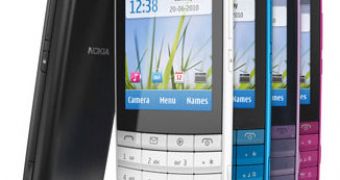
 14 DAY TRIAL //
14 DAY TRIAL // 
